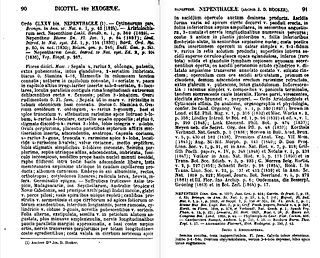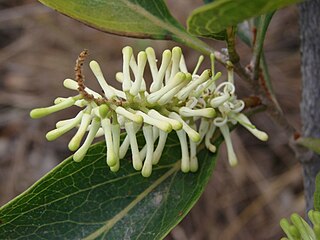
Plukenetia is a genus of plant of the family Euphorbiaceae. It is widespread in tropical regions of Africa, the Indian Subcontinent, Southeast Asia, and the Americas.

Securinega is a genus of plants in the family Phyllanthaceae, first described as a genus in 1789. As presently conceived, the genus is native to Madagascar and the Mascarene Islands in the Indian Ocean. In the past, it was considered to be much more widespread, thus explaining the long list of species formerly included.
- Securinega antsingyensisLeandri - W Madagascar
- Securinega capuroniiLeandri - W Madagascar
- Securinega durissimaJ.F.Gmel. - Madagascar, Mauritius, Réunion, Rodrigues Island
- Securinega perrieriLeandri - W Madagascar
- Securinega seyrigiiLeandri - W Madagascar

Acacia, commonly known as the wattles or acacias, is a large genus of shrubs and trees in the subfamily Mimosoideae of the pea family Fabaceae. Initially, it comprised a group of plant species native to Africa and Australasia, but it has now been limited to contain only the Australasian species. The genus name is New Latin, borrowed from the Greek ἀκακία (akakia), a term used by Dioscorides for a preparation extracted from the leaves and fruit pods of Vachellia nilotica, the original type of the genus. In his Pinax (1623), Gaspard Bauhin mentioned the Greek ἀκακία from Dioscorides as the origin of the Latin name.

Catharanthus roseus, commonly known as bright eyes, Cape periwinkle, graveyard plant, Madagascar periwinkle, old maid, pink periwinkle, rose periwinkle, is a species of flowering plant in the family Apocynaceae. It is native and endemic to Madagascar, but grown elsewhere as an ornamental and medicinal plant. It is a source of the drugs vincristine and vinblastine, used to treat cancer. It was formerly included in the genus Vinca as Vinca rosea.

Nepenthes pervillei is the only pitcher plant found in the Seychelles, where it is endemic to the islands of Mahé and Silhouette. It grows in rocky areas near granitic mountain summits, its roots reaching deep into rock fissures. The species has an altitudinal range of 350–750 m above sea level. Like all members of the genus, N. pervillei is dioecious, having separate male and female plants.

Dracaena reflexa is a tree native to Mozambique, Madagascar, Mauritius, and other nearby islands of the Indian Ocean. It is widely grown as an ornamental plant and houseplant, valued for its richly coloured, evergreen leaves, and thick, irregular stems.

Lasiodiscus, commonly known as red-hair bushes, is a small plant genus in the family Rhamnaceae. It is endemic to Africa and its adjacent islands.
Leslie Pedley was an Australian botanist who specialised in the genus Acacia. He is notable for bringing into use the generic name Racosperma, creating a split in the genus with some 900 Australian species requiring to be renamed, since the type species of Acacia, Acacia nilotica, now Vachellia nilotica, had a different lineage from the Australian wattles. However, the International Botanical Congress (IBC) in Melbourne in 2011 ratified their earlier decision to retain the name Acacia for the Australian species and to rename the African species.

Senegalia is a genus of flowering plants in the family Fabaceae. It belongs to the Mimosoid clade. Until 2005, its species were considered members of Acacia. The genus is still considered polyphyletic and will require further division. Senegalia can be distinguished from other acacias by its spicate inflorescences and non-spinescent stipules.

Vachellia is a genus of flowering plants in the legume family, Fabaceae, commonly known as thorn trees or acacias. It belongs to the subfamily Mimosoideae. Its species were considered members of genus Acacia until 2009. Vachellia can be distinguished from other acacias by its capitate inflorescences and spinescent stipules. Before discovery of the New World, Europeans in the Mediterranean region were familiar with several species of Vachellia, which they knew as sources of medicine, and had names for them that they inherited from the Greeks and Romans.
Vitis bryoniifolia is a prolific and adaptable, polygamo-dioecious species of climbing vine in the grape family native to China, where it is known as ying yu, or hua bei pu tao. The variant form ternata is known as san chu ying yu, meaning three-foliolate, or -leaflet ying yu. Ying yu translates to mean "hard jade".

Acacia 'Scarlet Blaze' is a cultivar of Acacia leprosa originating from Victoria in Australia. It is noted for its unusual red flowers.
Senegalia sakalava is a species of Senegalia that is endemic to Madagascar. Two varieties are recognised:

"Nepenthaceae" is a monograph by Joseph Dalton Hooker on the tropical pitcher plants of the genus Nepenthes. It was published in 1873 in the seventeenth and final volume of Augustin Pyramus de Candolle's Prodromus Systematis Naturalis Regni Vegetabilis, which was edited by Augustin's son, Alphonse. The monograph focused primarily on new discoveries from northern Borneo. Unlike most major works on Nepenthes, it included no illustrations.
Bremeria is a genus of flowering plants in the family Rubiaceae. It was described in 2005 to accommodate all the Indian Ocean species formerly placed in Mussaenda, except the widespread Mussaenda arcuata. The genus is indigenous to Madagascar, Mauritius and Réunion, and is found in humid to subhumid evergreen forests.

Roupala montana is a species of shrub or tree in the family Proteaceae which is native to much of the Neotropics. It is a morphologically variable species with four recognised varieties. The species is used medicinally in Venezuela, and as an aphrodisiac in Trinidad and Tobago and Venezuela.

Lumnitzera racemosa, commonly known as the white-flowered black mangrove, is a species of mangrove in the family Combretaceae. It is found on the eastern coast of Africa and other places in the western Indo-Pacific region. It has one accepted variety from the noniminate species, Lumnitzera racemosa var. lutea (Gaudich.) Exell.

Erasanthe is a genus of epiphytic orchids. It contains only one known species, Erasanthe henrici, endemic to Madagascar. Two subspecies are recognized:

The Field Elm cultivar Ulmus minor 'Coritana' was originally claimed by Melville, while he was searching in the neighbourhood of Leicestershire in 1936 for U. elegantissima, as a new species, which he called U. coritana. He later recorded its distribution in the counties of Bedfordshire, Berkshire, Buckinghamshire, Cambridgeshire, Essex, Hertfordshire, Leicestershire, Nottinghamshire, Norfolk, Oxfordshire, Suffolk and Warwickshire. Richens, however, dismissed U. coritana as 'an artificial aggregate' of local forms of Field Elm. Bean noted (1988) that Melville's U. coritana was not recognised in the Flora of the British Isles as a species distinct from U. carpinifolia [:U. minor].
Lactuca inermis is a species of wild lettuce native to sub-Saharan Africa, Madagascar, and the Arabian peninsula. A pioneer species often found in disturbed areas, it is of variable height, from very short to quite tall and woody. Local people consume its young leaves, perhaps with a light boiling, as a salad green or vegetable.














